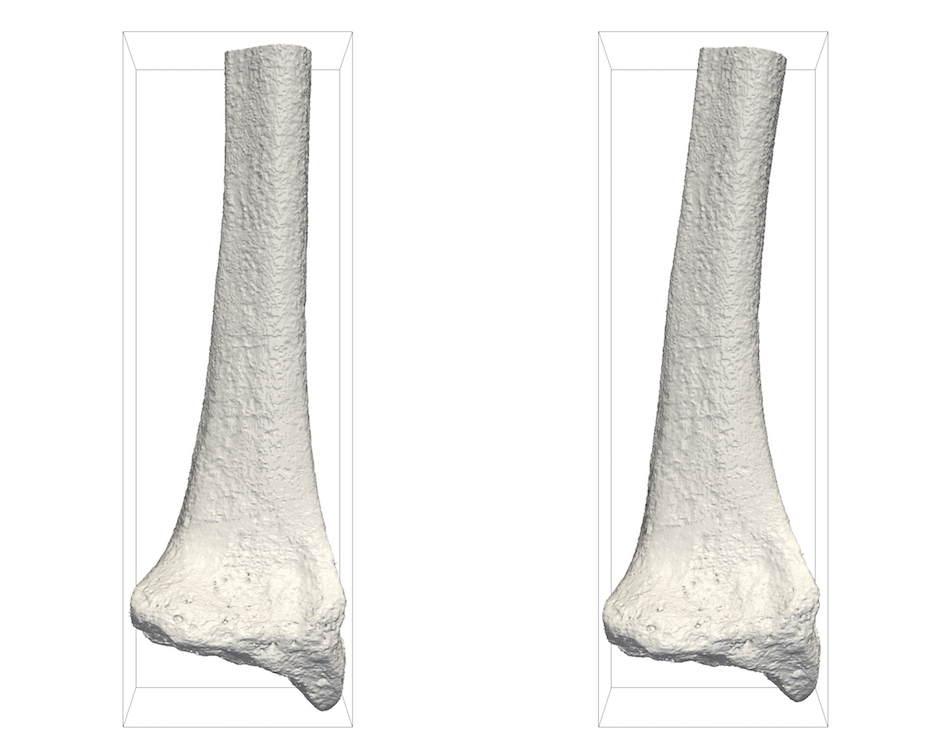About FAIM
FAIM is a finite element package designed for easy work flow to allow analysis of micro-computed tomography (µCT) data for the determination of mechanical characteristics of bone (e.g., bone strength). Applied to in vivo µCT technologies (e.g. XtremeCT), it provides a means to non-invasively determine bone strength and other features related to the mechanical integrity of bone.
The software package incorporates the three main components of a finite element package, including a pre-processor to generate models from µCT data, a highly efficient solver, and a post-processor that outputs both quantitative results and visualization of large datasets. It can be run on workstations that use Linux and macOS (and Windows).
FAIM Quick Facts
General
- Easy work flow for large (> 10M elements) µCT data sets.
- Established use in scientific studies.
- Runs on Linux, macOS and Windows workstations.
Pre-Processor
- Easily generates models with pre-set boundary conditions (e.g. axial compression).
- High-throughput capability for analyzing large numbers of models.
- Integrated with popular VTK Toolkit for generating infinitely customizable models using Python.
Solver
- Mesh-free solver for solving large µCT models.
- Solver is significantly more memory efficient than sparse-matrix solvers. It is ideally suited for solving large models that are typically generated from µCT data.
- Linear or elasto-plastic material definitions.
- Multi-threaded; scales to 12 cores and more.
- GPU accelerated on NVidia Tesla hardware.
Post-Processor
- Provides a quantitative report of results.
- 3D visualization in ParaView of solved models showing geometry, local stresses and strains, deformations and other quantities.
Selected Scientific Publications
Whittier DE, Manske SL, Kiel DP, Bouxsein M, Boyd SK, 2018. Harmonizing finite element modelling for non-invasive strength estimation by high-resolution peripheral quantitative computed tomography. J Biomech 80, 63-71.
Macdonald HM, Nishiyama KK, Kang J, Hanley DA, Boyd SK (2011). Age-related patterns of trabecular and cortical bone loss differ between sexes and skeletal sites: A population-based HR-pQCT study. J Bone Miner Res 26(1):50-62.
Campbell GM, Ominsky MS, Boyd SK (2010). Bone quality is partially recovered after the discontinuation of RANKL administration in rats by increased bone mass on existing trabeculae: an in vivo micro-CT study. Osteoporos Int 10.1007/s00198-010-1283-5.
MacNeil JA, Boyd SK (2008). Bone strength at the distal radius can be estimated from high-resolution peripheral quantitative computed tomography and the finite element method. Bone 42(6):1203-1213.
Su R, Campbell GM, Boyd SK (2006). Establishment of an architecture-specific experimental validation approach for finite element modeling of bone by rapid prototyping and high resolution computed tomography. Med Eng Phys 29(4):480-490.
Boyd SK, Müller R, Zernicke RF (2002). Mechanical and architectural bone adaptation in early stage experimental osteoarthritis. J Bone Miner Res 17(4):687-694.
